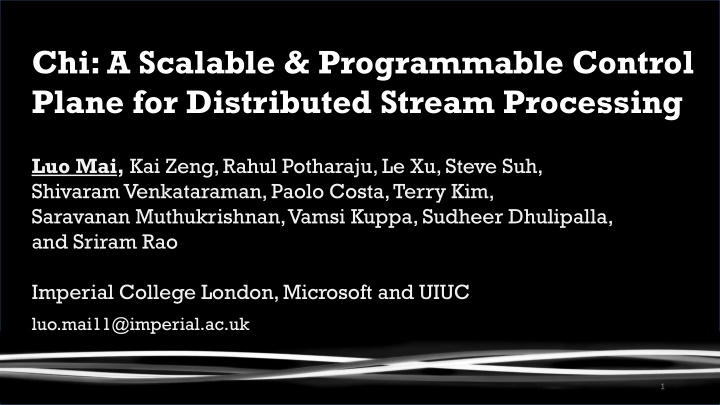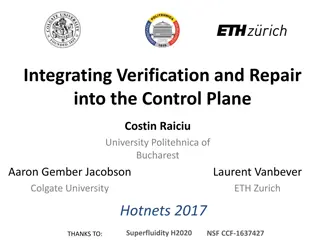Chi: A Scalable and Programmable Control Plane for Distributed Stream Processing
Distributed stream processing systems are increasingly crucial for various production use cases, such as real-time dashboards, machine learning, and interactive debugging. The challenges of handling large variability in production ingestion workloads and high-degree data skew in queries are addressed by Chi's scalable and flexible control plane. Chi focuses on achieving global consistency, enabling efficient modification monitoring, and reducing data plane overhead. The system embeds operations in the data plane, introducing novel designs for distributed control loops and non-blocking dataflow barriers.
Download Presentation

Please find below an Image/Link to download the presentation.
The content on the website is provided AS IS for your information and personal use only. It may not be sold, licensed, or shared on other websites without obtaining consent from the author.If you encounter any issues during the download, it is possible that the publisher has removed the file from their server.
You are allowed to download the files provided on this website for personal or commercial use, subject to the condition that they are used lawfully. All files are the property of their respective owners.
The content on the website is provided AS IS for your information and personal use only. It may not be sold, licensed, or shared on other websites without obtaining consent from the author.
E N D
Presentation Transcript
Chi: A Scalable & Programmable Control Plane for Distributed Stream Processing Luo Mai, Kai Zeng, Rahul Potharaju, Le Xu, Steve Suh, Shivaram Venkataraman, Paolo Costa, Terry Kim, Saravanan Muthukrishnan, Vamsi Kuppa, Sudheer Dhulipalla, and Sriram Rao Imperial College London, Microsoft and UIUC luo.mai11@imperial.ac.uk 1
Stream processing system has many critical production usages today Background Stream processing system Sources Real-time dashboard Machine learning Event Stateful operator Interactive Debugging 2
Production ingestion workloads shows large variability Problem >10 millions Variability of Event Count (minute) No common pattern 3
High-degree data skew is common in real-world queries Problem Event Count (minute) ~ 10 millions ~ 0.1 millions 4
Scalability and flexibility are keys to control plane Goals Control plane Global consistency Consistent distributed state updates through barriers Modification Monitoring Low data plane overhead Topology Programmability Individual user service requirements and resource constraints Hashing scheme Data plane 5
Continuous monitoring and modification is challenging State-of-the-art High modification cost Flink and Storm Freezing-the-world Drizzle [SOSP 17] and Spark Modifications on barriers Centralized masters Constant scheduling overhead and delay Limited extensibility High cost in latency and availability 6
Chi embeds operations in data plane -: novel control plane that Design Reactive functions in state machine Controller Punctuation as control message Travelling with data Channel barrier OnInit Punctuation OnBegin Chi novel designs Distributed control loops Non-blocking dataflow barrier Extensible state machine OnNext OnComplete OnDispose Moving barrier 7
Example: Monitoring Control message 1 5 2 User case Monitor group key and latency Move heavy groups to new operators if latency is high 4 Key properties Low overhead High scalability Reducer 3 Mapper 8
Example: Modification 1 User case Monitor group key and latency Move heavy groups to new operators if latency is high 6 New reducer 5 Key properties Low overhead High scalability Global consistency State dependency 2 4 Old reducer 9
Chi enables large stateful streaming systems to adapt quickly Chi in Action 10
Chi shows low overhead in data processing latency Chi in Action 11
Control messages has low overhead in data processing latency Evaluation 12
Summary Chi enables online monitoring and modification to streaming systems Global consistency Programmability Low overhead Chi opens up many research opportunities System self-regulation Multi-tenant scheduling Online query and runtime optimization Many more The awesome team I interned in at Microsoft is hiring! Please contact rapoth@microsoft.com if you are interested. 13
Chi - novel control plane that embeds its operations in scalable data plane Design Programmable state machine Controller Punctuation as control message Flow with tuples Travel in FIFO channel Execute asynchronously OnInit OnBegin Punctuation State Chi novel designs Control loop Asynchronous control barrier State machine with easy-to-extend functions OnNext OnComplete Moving barrier OnDispose 17
Enabling continuous monitoring and dynamic reconfiguration Requirements Policy Policy Policy SELECTCOUNT(s), s.area_code Online monitor G3: Intuitive programming interface FROM click_streams AS s Control plane TUMBLE WINDOW s.timestamp BY 60 G3: Low-latency feedback-loop GROUP BY s.area_code G1: Barrier guarantee Online reconfigure Conf. #2 Conf. #1 Parallelism Batch size Hashing scheme 18
Enabling continuous monitoring and online reconfiguration Goal Control plane SELECTCOUNT(s), s.area_code Online parameter reconfiguration Feedback-loop FROM click_streams AS s TUMBLE WINDOW s.timestamp BY 60 GROUP BY s.area_code Continuous monitoring Batch size Topology Hashing scheme 19 Data plane
Embed control plane in data plane Key idea Policy Policy Policy [Punctuation / watermark] Special data events for notification Travel with data events -> low overhead Travel asynchronously -> no lock Travel in FIFO channel -> channel barrier Control plane Start control Complete control [Potential benefits] Piggyback control information in punctuations Extending punctuations to be control messages to run both monitoring and reconfiguration Coordinate control message propagation Consolidating channel barrier as dataflow barrier Controller as stream operators Reusing programming and scaling-out techniques Control state Punctuation Dataflow barrier 20
Guarantee freeze-the-world update through asynchronous execution Runtime [Control life-cycle steps] 1. Start control with a meta topology including data, state and control dependency 2. Generate operator control configurations and piggyback into control message 3. Broadcast messages to dataflow leaves 4. Leaves record input channel sequence, run control actions, and broadcast messages downstream 5. Operator blocks input channel once receiving a control message (if barrier is required) 6. Operator perform control actions when receiving control messages from all inputs 7. Operator broadcast control messages to all downstream (and unblock inputs if need) 8. Controller do post-control actions when receiving messages from all dataflow roots 1 2 8 3 Controller 4 New operator Control dependency State dependency 5 7 6 21 Meta topology
Guaranteeing global barrier semantic through decentralized execution Runtime [Decentralized execution] Operator knows all old data are processed if all parents mark the end by control messages Operator reconfigure itself to process new data Operator notifies dependents the end of old data [Execution sequence] Computation dependency State dependency Control dependency Operator Dependents Parents [Blocking control messages] Block channel if receiving control message from parent Unblock inputs when notifying dependents 22























